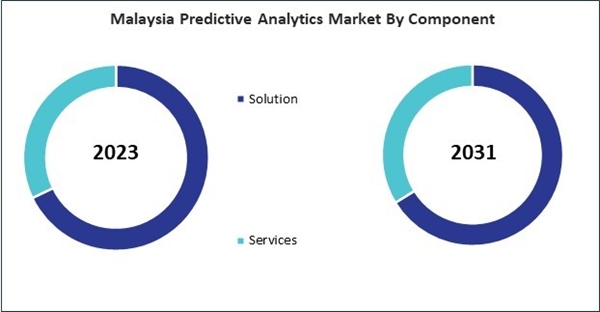The China market dominated the Asia Pacific Predictive Analytics Market by Country in 2023, and would continue to be a dominant market till 2031; thereby, achieving a market value of $4.21 billion by 2031. The Japan market is registering a CAGR of 21.8% during (2024 - 2031). Additionally, The India market would showcase a CAGR of 23.4% during (2024 - 2031).

The adoption of this has accelerated across industries, driven by several factors. Many businesses have adopted this by integrating it with their CRM systems. This integration allows for enhanced customer insights, better targeting of marketing campaigns, and improved customer service through predictive lead scoring and customer behavior analysis.
In addition, this is increasingly being used in real-time customer support environments. By analyzing real-time customer interactions and support tickets, organizations can proactively address issues, predict customer needs, and enhance the overall support experience. This adoption is expanding in the public sector, including public safety, urban planning, and social services.
China’s IT industry has become a global hub for technological innovation. The continuous advancements in AI, machine learning, and big data technologies have fuelled the development and adoption of these solutions. Significant investments in research and development by Chinese tech giants such as Alibaba, Tencent, and Huawei have accelerated the creation of cutting-edge these tools and platforms. Banks and financial institutions in India used these to gain deeper insights into customer behaviour, enabling personalized product offerings, targeted marketing campaigns, and improved customer retention strategies. At the end of FY23, the banking sector reported deposits of $2.2 Tn and loans of $1.67 Tn, leading to a credit-deposit ratio of 75.8% (highest in the past three years). The BFSI sector in India faced increasing threats from cyber fraud and financial crimes. Predictive analytics helped institutions identify fraudulent activities in real time, predict potential risks, and implement preventive measures, enhancing overall security. Thus, the rising IT industry and increasing BFSI sector drive the market's growth.
Based on Deployment Mode, the market is segmented into Cloud, and On-Premise. Based on Component, the market is segmented into Solution (Customer Analytics, Financial Analytics, Sales & Marketing Analytics, Risk Analytics, and Supply Chain Analytics), and Services (Professional, and Managed). Based on Organization Size, the market is segmented into Large Enterprise, and Small & Medium Enterprise. Based on Vertical, the market is segmented into BFSI, Healthcare, Manufacturing, Transportation & Logistics, Energy & Utilities, Government, Retail, and Telecom & IT. Based on countries, the market is segmented into China, Japan, India, South Korea, Australia, Malaysia, and Rest of Asia Pacific.
List of Key Companies Profiled
- IBM Corporation
- Oracle Corporation
- SAP SE
- Microsoft Corporation
- SAS Institute Inc.
- NTT Data Corporation
- TIBCO Software, Inc. (Vista Equity Partners Management, LLC)
- Salesforce, Inc.
- Alteryx, Inc.
- Fair Isaac Corporation (FICO)
Market Report Segmentation
By >Deployment Mode
- Cloud
- On-Premise
By Component
- Solution
- Customer Analytics
- Financial Analytics
- Sales & Marketing Analytics
- Risk Analytics
- Supply Chain Analytics
- Services
- Professional
- Managed
By Organization Size
- Large Enterprise
- Small & Medium Enterprise
By Vertical
- BFSI
- Healthcare
- Manufacturing
- Transportation & Logistics
- Energy & Utilities
- Government
- Retail
- Telecom & IT
By Country
- China
- Japan
- India
- South Korea
- Australia
- Malaysia
- Rest of Asia Pacific









